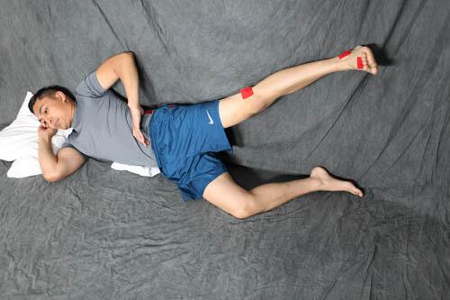Approach
The management of iliotibial band syndrome (ITBS) is largely conservative with the overall goal of treatment being to minimize the friction of the iliotibial band (ITB) as it slides over the lateral femoral condyle.[35] Four phases of ITBS have been described, which guide treatment approach:[31]
Acute (characterized by inflammation and pain)
Subacute (beginning after inflammation and pain subside)
Recovery and strengthening (beginning once range of motion and myofascial restrictions are resolved)
Return to running (beginning when open-chain and closed-chain exercises can be performed pain free)
Although conservative treatment is the mainstay of management, there is a lack of evidence to support its effectiveness. Future high-quality studies are needed.[36][37][38]
Acute
In the acute phase, goals of treatment include reducing local inflammation and providing effective pain relief with nonsteroidal anti-inflammatory drugs.
Patients should be advised regarding activity modification. In mild ITBS, this involves limiting physical activity up to the point (time or distance) at which symptoms begin. In severe ITBS, patients should avoid aggravating activities but can consider alternative forms of physical activity that don’t engage the affected limb. Any activity that requires repeated knee flexion and extension is prohibited. Ice should be used on the affected area.
Combination local anesthetic and corticosteroid injections are recommended for patients with severe pain or swelling and in refractory cases.[39] [Figure caption and citation for the preceding image starts]: Injection site for iliotibial bandFrom the personal collection of Dr J.C. Mak [Citation ends].
Subacute
The subacute phase is characterized by subsiding inflammation and pain. During this phase, emphasis is on stretching of the ITB and soft-tissue therapy for any myofascial restrictions (e.g., trigger points, muscle contractures, fascial adhesions) which supports muscle strengthening and reeducation. This approach can be combined with the use of a foam roll.
Recovery and strengthening
Recovery and strengthening can begin once range of motion and myofascial restrictions have been resolved. This phase focuses on strengthening exercises to promote movement patterns and improve hip abductor strength.[Figure caption and citation for the preceding image starts]: Hip abduction in side-lying position with hip extended for posterior gluteus medius emphasisBaker RL et al. Iliotibial band syndrome in runners: biomechanical implications and exercise interventions. Phys Med Rehabil Clin N Am. 2016 Feb;27(1):53-77; used with permission [Citation ends].
Return to running
In this final phase, which begins when open-chain and closed-chain exercises can be performed pain free, patients are gradually reintroduced to running.
Refractory to conservative treatment: surgery
Most patients will respond to a conservative treatment approach.[38] However, surgery may occasionally be required to decrease impingement of the ITB on the lateral femoral epicondyle. The surgery involves resection, when the leg is in a 30° flexed position, of a triangular piece of the ITB from the area overlying the lateral epicondyle. Additionally, the PLAR technique (which combines percutaneous lengthening of the ITB and arthroscopic debridement of the lateral synovial recess) may be effective in allowing a return to previous sports performance levels.[40]
Use of this content is subject to our disclaimer